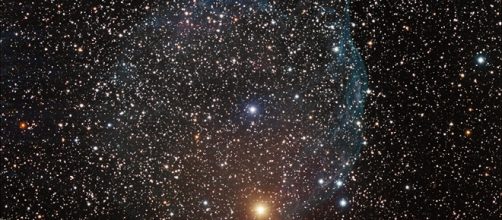Astronomers using NASA´s Hubble Space Telescope peered into a bubble of gas and dust orbiting a Wolf-Rayet Star- a type of star characterized by unusual spectra and a temperature ranging from 30,000-200,00 K. This star is called Ez Canis Majoris and is located within the constellation Canis Major. This star is responsible for creating the bubble emission nebula known as Sh2-308. The Wolf-Rayet Star threw out its outermost layers creating the filaments. The continuing radiation of the star pushes the shell farther away from the nucleus of the star like a balloon.
It´s estimated that the outer limits of the bubble are presently at around 60 light years of distance in diameter.
Sh2-308
This is a visible emission nebula in the constellation Canis Major located at approximately 5,200 light years away from the earth and at 8° south of Sirius-the brightest star. It surrounds a Wolf-Rayet star known as EZ Canis Majoris (the great dog). It´s believed that the bubble originated about 70,000 years ago due to the loss of matter by expulsions of the star. The strong winds of thee Rayet star sweeps the surrounding matter, forming bubbles of gas and giving the nebula its characteristic features.
Wolf-Rayet Star
This is a rare type of star which shows emission lines of ionized helium and nitrogen, possibly carbon, indicating the production of heavy elements on its surface.
These types of stars are among the most massive and luminous stars in the entire universe. They are evolved massive stars that have depleted their hydrogen and are fusing helium or heavier elements in the nucleus. They are highly luminous bodies due to their extreme temperatures which range anywhere from 30,000-200,000 degrees K. the fast stellar winds of these stars sweep the neighboring material, forming a bubble nebula. WR stars are rare and not fully understood to date.
Supernova explosions
It´s believed that many type 1b and type 1c supernovae precursors are WR stars, as both types of supernova-1b and 1c lack hydrogen lines in their spectra, which correspond to WR stars. WR stars are estimated to experience collapsation when an iron core has been generated.
It´s believed that these cosmic bubbles will have an end when the same stars that formed them will eventually subsumed them in violent supernova explosions. In some cases, it´s possible that direct collapsation of the core into a black hole would not produce an observable explosion.

